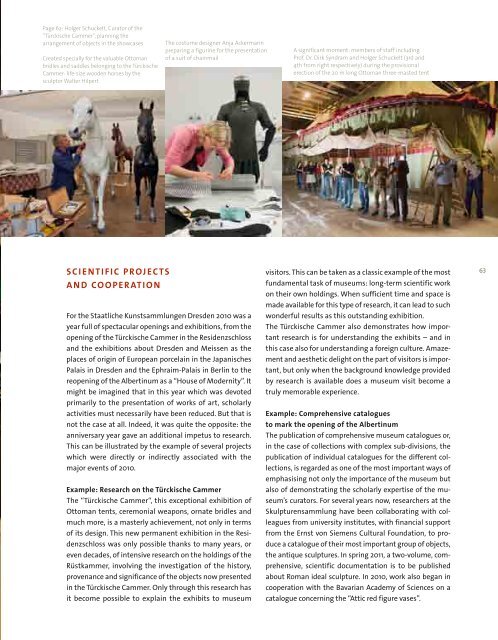Annual Report 2010 - Staatliche Kunstsammlungen Dresden
Annual Report 2010 - Staatliche Kunstsammlungen Dresden
Annual Report 2010 - Staatliche Kunstsammlungen Dresden
You also want an ePaper? Increase the reach of your titles
YUMPU automatically turns print PDFs into web optimized ePapers that Google loves.
Page 62: Holger schuckelt, Curator of the<br />
“Türckische Cammer”, planning the<br />
arrangement of objects in the showcases<br />
Created specially for the valuable Ottoman<br />
bridles and saddles belonging to the Türckische<br />
Cammer: life-size wooden horses by the<br />
sculptor Walter Hilpert<br />
SCI entI FIC pRoJ eCtS<br />
An D CoopeRAtIon<br />
The costume designer anja ackermann<br />
preparing a figurine for the presentation<br />
of a suit of chainmail<br />
For the <strong>Staatliche</strong> <strong>Kunstsammlungen</strong> <strong>Dresden</strong> <strong>2010</strong> was a<br />
year full of spectacular openings and exhibitions, from the<br />
opening of the Türckische Cammer in the Residenzschloss<br />
and the exhibitions about <strong>Dresden</strong> and Meissen as the<br />
places of origin of European porcelain in the Japanisches<br />
Palais in <strong>Dresden</strong> and the EphraimPalais in Berlin to the<br />
reopening of the Albertinum as a “House of Modernity”. It<br />
might be imagined that in this year which was devoted<br />
primarily to the presentation of works of art, scholarly<br />
activities must necessarily have been reduced. But that is<br />
not the case at all. Indeed, it was quite the opposite: the<br />
anniversary year gave an additional impetus to research.<br />
This can be illustrated by the example of several projects<br />
which were directly or indirectly associated with the<br />
major events of <strong>2010</strong>.<br />
example: Research on the türckische Cammer<br />
The “Türckische Cammer“, this exceptional exhibition of<br />
Ottoman tents, ceremonial weapons, ornate bridles and<br />
much more, is a masterly achievement, not only in terms<br />
of its design. This new permanent exhibition in the Residenzschloss<br />
was only possible thanks to many years, or<br />
even decades, of intensive research on the holdings of the<br />
Rüstkammer, involving the investigation of the history,<br />
provenance and significance of the objects now presented<br />
in the Türckische Cammer. Only through this research has<br />
it become possible to explain the exhibits to museum<br />
a significant moment: members of staff including<br />
Prof. Dr. Dirk syndram and Holger schuckelt (3rd and<br />
4th from right respectively) during the provisional<br />
erection of the 20 m long Ottoman three-masted tent<br />
visitors. This can be taken as a classic example of the most<br />
fundamental task of museums: longterm scientific work<br />
on their own holdings. When sufficient time and space is<br />
made available for this type of research, it can lead to such<br />
wonderful results as this outstanding exhibition.<br />
The Türckische Cammer also demonstrates how important<br />
research is for understanding the exhibits – and in<br />
this case also for understanding a foreign culture. Amazement<br />
and aesthetic delight on the part of visitors is important,<br />
but only when the background knowledge provided<br />
by research is available does a museum visit become a<br />
truly memorable experience.<br />
example: Comprehensive catalogues<br />
to mark the opening of the Albertinum<br />
The publication of comprehensive museum catalogues or,<br />
in the case of collections with complex subdivisions, the<br />
publication of individual catalogues for the different collections,<br />
is regarded as one of the most important ways of<br />
emphasising not only the importance of the museum but<br />
also of demonstrating the scholarly expertise of the museum’s<br />
curators. For several years now, researchers at the<br />
Skulpturensammlung have been collaborating with colleagues<br />
from university institutes, with financial support<br />
from the Ernst von Siemens Cultural Foundation, to produce<br />
a catalogue of their most important group of objects,<br />
the antique sculptures. In spring 2011, a twovolume, comprehensive,<br />
scientific documentation is to be published<br />
about Roman ideal sculpture. In <strong>2010</strong>, work also began in<br />
cooperation with the Bavarian Academy of Sciences on a<br />
catalogue concerning the “Attic red figure vases”.<br />
63

















